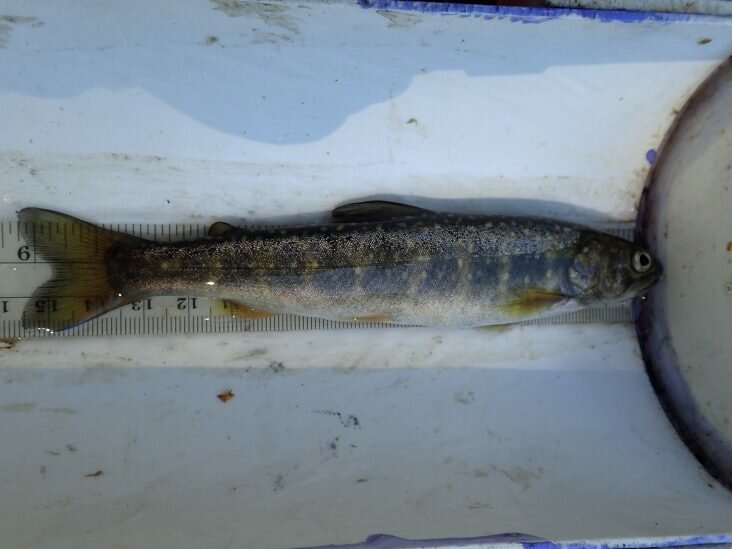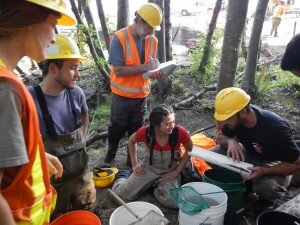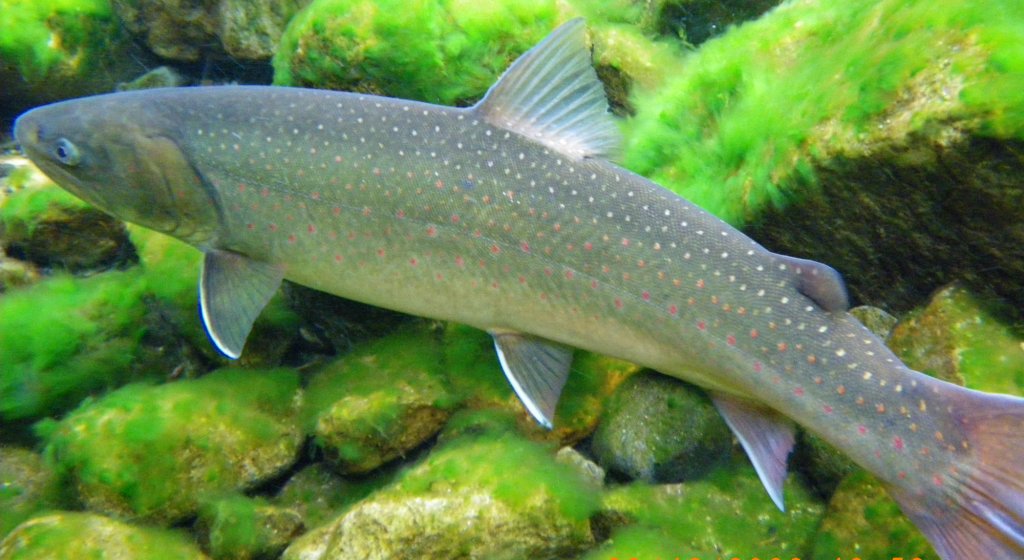Bull trout utilizing new tributaries in the I-90 Corridor


Paul James and students from Central Washington University conducting monitoring in Townsend Creek. Photo: CWU
Located at the headwaters of the Yakima River watershed, the Interstate-90 Snoqualmie Pass East Project has a tremendous ability to restore the natural flow and function of waterways that run under and lie adjacent to the freeway. The Project is reconnecting fish to habitat they’ve been cut off from for decades. Paul James, a fish and stream ecologist with Central Washington University, has been leading research crews for nearly ten years, and their work is already showing the positive impacts of the project as it is being constructed.
Starting in 2009 before any construction began on the highway project, Paul and his students began collecting information within the 15 mile project area for baseline population surveys to see what fish were present in the tributary streams that run under the interstate highway.
Monitoring was conducted to record fish species presence in nine streams (Swamp Creek, Bonnie Creek, Noble Creek, Price Creek, Townsend Creek, Resort Creek, Rocky Run Creek, Coal Creek, and Gold Creek) that are tributaries to either the Keechelus Reservoir or the upper mainstem Yakima River. Cutthroat trout were abundant in most streams and bull trout were found in Gold Creek. Most surprising to researchers were the few individual juvenile Chinook salmon found in Swamp Creek that were believed to have come up these tributaries several years in a row to escape the high flows in the Yakima River mainstem. Exemplifying the movement needs of fish species across the landscape, one of these juvenile Chinook left Swamp Creek after Paul’s crew tagged it and was identified moving downstream past John Day Dam (over 130 river miles) heading out to the ocean.
As construction of the Project is underway Paul’s crew continues their annual monitoring of these streams. The data is now beginning to tell a story of recovery where wildlife underpasses and restoration efforts are completed that reconnect fish habitat. His team has now recorded bull trout present in 4 additional tributaries: Coal Creek, Rocky Run, Resort Creek, and Townsend Creek, and in some cases, in multiple years.
“Bull trout are amazing because they used to be widespread throughout northwestern waters, and they are sensitive to needing ice cold clean water. So while their numbers have reduced greatly, they have become a perfect indicator of environmental quality. Where you find them, you find high quality water,” said Paul. “These fish swim around a lot seeking out new streams to rear and feed, therefore the more connectivity the more they will be able to move around and be widespread. We’ve already found them in four streams in the Project area where they’ve haven’t been recorded in recent history”, lending new information about their distribution and needs for recovery.
The bull trout recorded in Townsend Creek last month was a sub-adult about two-three years old. The significance of this age is that it is when bull trout are believed to start dispersing; they begin looking for food and shelter, or where they can rear before returning several years later to spawn or lay their eggs in their natal stream. Because of their small size, and their shifting diets from eating insects to larger prey, the sub-adult bull trout is vulnerable.
“Think of Disney’s “Finding Nemo” when Nemo was at the edge of the open water,” said Judy Neibauer with U.S. Fish and Wildlife. “These fish are kind of like that character, they come with genes that say I am a top predator but they don’t know how to hide well and are very curious but cautious. These fish are migratory and need passage back and forth into tributaries from the reservoirs and the mainstem rivers, between spawning habitat and their forage habitat. The Department of Transportation and Federal Highway Administration work happening along I-90 is helping by opening up some of these tributary habitats for bull trout and their prey. They are managing for critical connections for bull trout in the upper Yakima.”
With bull trout a priority species for recovery across much of Washington, the I-90 project is a catalytic pilot for showing how bull trout may respond to restoration actions that reconnect them to potential habitat.
In addition to the recovery of bull trout into additional tributaries, Paul’s research has also shown the recolonization of reconstructed stream channels under the interstate in Phase 1 of this Project by aquatic insects and fish species like cutthroat trout. This recovery is happening immediately following the big disturbances of construction including the temporary re-routing of streams, meaning as this project moves forward we can expect to see this narrative of recovery continue.
“It’s the Field of Dreams,” observed Paul. “You build it and they will come”




2 thoughts on “Bull trout utilizing new tributaries in the I-90 Corridor”